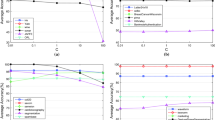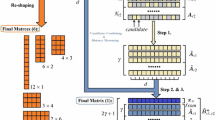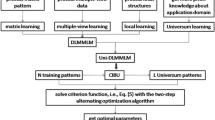Abstract
Regularization has the ability to effectively improve the generalization performance, which is due to its control for model complexity via priori knowledge. Matrixized learning as one kind of regularization methods can help improving classification accuracy and reducing computational complexity when dealing with matrix data. This success is attributed to the exploitation of structural knowledge of matrix data. This paper generalizes the matrixized learning through taking the advantage of the Universum data which does not belong to any class of interest in classification problems. The generalized method can not only keep the structural knowledge of the matrix data themselves, but also acquire a priori domain knowledge from the whole data distribution. In implementation, we incorporate the previous matrixized work MatMHKS with the Universum strategy, and develop a novel regularized matrix-pattern-oriented classification machine named UMatMHKS. The subsequential experiments have validated the effectiveness of the proposed UMatMHKS. The results has shown that the proposed UMatMHKS achieved an improvement in classification accuracy of 1.52% over the MatMHKS and 3.20% over the USVM on UCI benchmark datasets. The UMatMHKS also has a shorter average running time of 0.41 s over the 0.71 s from the MatMHKS on UCI datasets. Three main characteristics of UMatMHKS lie in: (1) making full use of the domain knowledge of the whole data distribution as well as inheriting the advantages of the matrixized learning; (2) applying Universum learning into the matrixized learning framework; (3) owning a tighter generalization risk bound.





Similar content being viewed by others
References
Chen H, Li L, Peng J (2009) Error bounds of multi-graph regularized semi-supervised classification. Inf Sci 179(12):1960–1969
Hagiwara K, Kuno K (2000) Regularization learning and early stopping in linear networks. In: IEEE international joint conference on neural networks, vol 4, pp 511–516
Mario R, Antonio I, Raimundas J, Rosanna V (2013) Fuzzy regularized generalized eigenvalue classifier with a novel membership function. Inf Sci 245:53–62
Pan Z, You X, Chen H, Tao D, Pang B (2013) Generalization performance of magnitude-preserving semi-supervised ranking with graph-based regularization. Inf Sci 221:284–296
Reshma K, Suresh C (2008) Regularized least squares support vector regression for the simultaneous learning of a function and its derivatives. Inf Sci 178(17):3402–3414
Shi X, Yang Y, Guoa Z, Lai Z (2014) Face recognition by sparse discriminant analysis via joint l2,1-norm minimization. Pattern Recognit 47(7):2447–2453
Zhao H, Wong W (2014) Regularized discriminant entropy analysis. Pattern Recognit 47(2):806–819
Ivanov V, Ivanov V, Vasin V, Tanana V (2002) Theory of linear ill-posed problems and its applications. Walter de Gruyter & Co, Berlin
Wang Z, Chen S, Gao D (2011) A novel multi-view learning developed from single-view patterns. Pattern Recognit 44(10):2395–2413
Pumplin J, Stump D, Tung W (2002) Multivariate fitting and the error matrix in global analysis of data. Phys Rev D 65(1):014011
Chen S, Wang Z, Tian Y (2007) Matrix-pattern-oriented ho-kashyap classifier with regularization learning. Pattern Recognit 40(5):1533–1543
Chen S, Zhu Y, Zhang D, Yang J (2005) Feature extraction approaches based on matrix pattern: Matpca and matflda. Pattern Recognit Lett 26(8):1157–1167
Nanni L, Brahnam S, Lumini A (2012) Matrix representation in pattern classification. Expert Syst Appl 39(3):3031–3036
Wang H, Ahuja N (2005) Rank-r approximation of tensors using image-as-matrix representation. In: IEEE Computer Society conference on computer vision and pattern recognition, vol 2, pp 346–353
Yang J, Zhang D, Frangi A, Yang J (2004) Two-dimensional pca: a new approach to appearance-based face representation and recognition. IEEE Trans Pattern Anal Mach Intell 26(1):131–137
Li J, Janardan R, Li Q (2004) Two-dimensional linear discriminant analysis. Adv Neural Inf Process Syst 17:1569–1576
Abdi H, Williams L (2010) Principal component analysis. Wiley Interdiscip Rev 2(4):433–459
Zhang D, Jing X, Yang J (2006) Biometric image discrimination technologies. Idea Group Publishing, Hershey
Felzenszwalb P, McAuley J (2011) Fast inference with min-sum matrix product. IEEE Trans Pattern Anal Mach Intell 33(12):2549–2554
Seung D, Lee L (2001) Algorithms for non-negative matrix factorization. Adv Neural Inf Process Syst 13:556–562
Gao B, Woo W, Dlay S (2012) Variational regularized 2-d nonnegative matrix factorization. IEEE Trans Neural Netw Learn Syst 23(5):703–716
Cai D, He X, Han J, Huang T (2011) Graph regularized nonnegative matrix factorization for data representation. IEEE Trans Pattern Anal Mach Intell 33(8):1548–1560
Guan N, Tao D, Luo Z, Yuan B (2012) Online nonnegative matrix factorization with robust stochastic approximation. IEEE Trans Neural Netw Learn Syst 23(7):1087–1099
Li H, Chen N, Li L (2012) Error analysis for matrix elastic-net regularization algorithms. IEEE Trans Neural Netw Learn Syst 23(5):737–748
Weston J, Collobert R, Sinz F, Bottou L, Vapnik V (2006) Inference with the universum. In: International conference on machine learning, pp 1009–1016
Yang L, Hanneke S, Carbonell J (2013) A theory of transfer learning with applications to active learning. Mach Learn 90(2):161–189
Luo Y, Liu T, Tao D, Xu C (2014) Decomposition-based transfer distance metric learning for image classification. IEEE Trans Image Process 23(9):3789–3801
Luo Y, Wen Y, Tao D, Gui J, Xu C (2016) Large margin multi-modal multi-task feature extraction for image classification. IEEE Trans Image Process 25(1):414–427
Liu W, Tao D, Cheng J, Tang Y (2014) Multiview hessian discriminative sparse coding for image annotation. Comput Vis Image Underst 118:50–60
Vapnik V, Vashist A (2009) A new learning paradigm: learning using privileged information. Neural Netw 22(5–6):544–557
Vapnik V, Izmailov R (2015) Learning using privileged information: similarity control and knowledge transfer. J Mach Learn Res 16(1):2023–2049
Vapnik V, Kotz S (1982) Estimation of dependences based on empirical data. Springer, New York
Vapnik V (1999) The nature of statistical learning theory. Springer, New York
Sinz F, Chapelle O, Agarwal A, Schölkopf B (2008) An analysis of inference with the universum. Adv Neural Inf Process Syst 20:1369–1376
Chen S, and Zhang C (2009) Selecting informative universum sample for semi-supervised learning. In: International joint conference on artificial intelligence, pp 1016–1021
Qi Z, Tian Y, Shi Y (2012) Twin support vector machine with universum data. Neural Netw 36:112–119
Qi Z, Tian Y, Shi Y (2014) A nonparallel support vector machine for a classification problem with universum learning. J Comput Appl Math 263:288–298
Zhang D, Wang J, Si L (2011) Document clustering with universum. In: International conference on research and development in information retrieval, pp 873–882
Peng B, Qian G, Ma Y (2008) View-invariant pose recognition using multilinear analysis and the universum. Adv Visual Comput 5359:581–591
Shen C, Wang P, Shen F, Wang H (2012) Uboost: boosting with the universum. IEEE Trans Pattern Anal Mach Intell 34(4):825–832
Chen X, Chen S, Xue H (2012) Universum linear discriminant analysis. Electron Lett 48(22):1407–1409
Wang Z, Zhu Y, Liu W, Chen Z, Gao D (2014) Multi-view learning with universum. Knowl-Based Syst 70:376–391
Leski J (2003) Ho-kashyap classifier with generalization control. Pattern Recognit Lett 24(14):2281–2290
Bache K, Lichman M (2013) UCI machine learning repository, University of California, Irvine, School of Information and Computer Sciences. http://archive.ics.uci.edu/ml
Tsang I, Kocsor A, Kwok J (2006) Efficient kernel feature extraction for massive data sets. In: International conference on knowledge discovery and data mining, pp 724–729
Kreßel U (1999) Pairwise classification and support vector machines. In: Advances in kernel methods, pp. 255–268
Xu Q, Liang Y (2001) Monte carlo cross validation. Chemometr Intell Lab Syst 56(1):1–11
Hollander M, Wolfe D, Chicken E (2013) Nonparametric statistical methods. Wiley, New York
Ye J (2005) Generalized low rank approximations of matrices. Mach Learn 61(1–3):167–191
Koltchinskii V (2001) Rademacher penalties and structural risk minimization. IEEE Trans Inf Theory 47(5):1902–1914
Vapnik V, Chervonenkis A (1971) On the uniform convergence of relative frequencies of events to their probabilities. Theory Probab Appl 16(2):264–280
Koltchinskii V, Panchenko D (2000) Rademacher processes and bounding the risk of function learning. High dimensional probability II. Springer, New York, pp. 443–457
Acknowledgements
This work was partially supported by Natural Science Foundations of China under Grant Nos. 61672227 and 61272198, the 863 Plan of China Ministry of Science and Technology under Grant No. 2015AA020107, and the Fundamental Research Funds for the Central Universities.
Author information
Authors and Affiliations
Corresponding authors
Rights and permissions
About this article
Cite this article
Li, D., Zhu, Y., Wang, Z. et al. Regularized Matrix-Pattern-Oriented Classification Machine with Universum. Neural Process Lett 45, 1077–1098 (2017). https://doi.org/10.1007/s11063-016-9567-1
Published:
Issue Date:
DOI: https://doi.org/10.1007/s11063-016-9567-1




